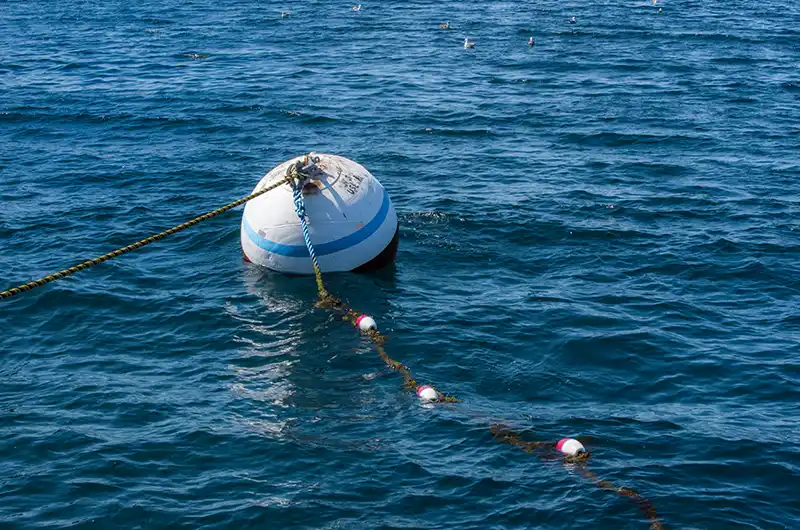
What Is a Mooring Buoy?
A mooring buoy is a floating, white-and-blue marker that’s permanently anchored to the seabed so boaters can tie up without ever lowering their own anchor—saving time, reducing crowding, and sparing fragile habitats such as coral reefs and seagrass beds from anchor scars.
Picture a sphere bobbing at the surface. Beneath it runs a heavy-duty chain or synthetic line to a seabed anchor. Instead of dropping your own anchor, you pick up the short “pendant” line on the buoy and secure it to your bow cleat.
Your vessel stays put while the reef beneath remains untouched. The U.S. Coast Guard designates these buoys by a white body with a single horizontal blue band—a color scheme intentionally chosen so they’re never confused with navigation marks or hazard buoys.
What is a Mooring Buoy For?
- Environmental shield. Mooring buoys cut the risk of damaging reefs and coral significantly because the rate of anchoring in sensitive areas is typically halved.
- Better boating experience. No dragging gear out, no need to find the scope, and far less swing room required which is great news in packed harbors or over delicate bottom.
Parts of a Mooring Buoy
Knowing the different parts of a mooring buoy will make for a smoother experience.
| Component | What it does |
|---|---|
| Buoy body | Keeps pickup line afloat and shows daymark |
| Pendant / pickup line | Short floating line you retrieve with a boathook |
| Mooring line / chain | Transfers load from vessel to anchor |
| Seabed anchor | Permanent holding point |
| Hardware | Allows rotation, prevents twist |
Configurations of Mooring Buoys
Understand the different types of mooring buoys and how your vessel may or may not be able to anchor at one.
| Mooring Style | How it’s Laid Out | Best For | Typical Vessel Size |
| Single-Point (SPM) | One anchor, one buoy. Boat can swing freely. | Tankers & super-yachts loading offshore; exposed roadsteads | 50 ft – >1000 ft |
| Swing Mooring (Recreational SPM) | Small-boat version of SPM found in harbors & sanctuaries | Day-use dive, snorkel & fishing boats | Up to ~60 ft |
| Multi-Point / Trotline | Several buoys on one ground line | Crowded marinas, rafting multiple boats | Up to ~80 ft (per pennant) |
| Fore-and-Aft | Two fixed points, bow and stern pennants | Rivers & canals with strong current, keeping boats aligned | 15–120 ft |
Using a Mooring Buoy
- Approach from down-wind or down-current at idle; have crew ready with boathook.
- Grab only the floating pickup line, then thread your own dock line through the buoy’s eye or pendant thimble. Never tie directly to the thin pickup line.
- Keep the pull horizontal. If the buoy begins to submerge, you’re yanking too hard, ease additional scope or rig a bridle.
- Inspect visually. Chafed line, cracked buoy, or missing hardware? Note the location and report it to the managing authority.
- Mind the time limit. Rules vary by location but know that day-use buoys can be capped for use at a certain number of hours and for a certain length of vessel. Always check the local notice.
Different Buoy Colors
Don’t confuse mooring buoys with buoys that aid navigation. Here are the most common types you’ll see on the water:
- White with Blue Horizontal Line – the official mooring buoy
- White with Orange Markings – Regulatory buoys that signify warning, danger, information, and/or exclusion zones
- Red Buoys – Starboard-side channel markers; think “red right return”
- Green Buoys – Port-side channel markers
- Yellow Buoys – Special purpose that are cautionary for dredging, fish net areas, military zones, etc.
- Black & Red Horizontal Stripes – Isolated danger buoys, this is an international standard
Key Takeaways for Every Boater
- Use them when you can. It’s the single fastest way to cut your environmental footprint afloat.
- Treat them gently. Line through the eye, engine in gear only after you’ve cast off.
- Stay informed. Local buoy rules differ; a quick glance at the chart or phone call to authorities keeps you out of trouble.
Whether you skipper a 20-foot center console or a 200-foot megayacht, mastering mooring buoys turns you into a better neighbor on the water and a steward of the underwater world below. Next time the familiar blue-banded ball beckons, grab the pendant, secure your lines, and relax: you’ve just anchored without an anchor.
